[ad_1]
School users and graduate pupils at Rutgers University suspended their five-day strike on April 15 right after agreeing to a settlement framework with the administration. The strike was to some degree unusual for American academia because of to its high level of coordination among unique university unions.
Industry experts, nevertheless, say faculties in some regions can count on more of these sorts of actions as bigger education emerges from the pandemic.
A lot more strikes and exercise
In just the first couple of months of 2023, there have been 9 strikes at colleges and universities, which include these by clerical and company employees, explained William Herbert, government director of the National Heart for the Examine of Collective Bargaining in Better Schooling and the Professions at Hunter Faculty, in New York City. By distinction, there have been only 13 strikes at American faculties in the entire of 2018 and only 5 in 2017.
“There’s unquestionably a publish-pandemic strike wave which the Rutgers strike is one of numerous,” Herbert mentioned. “The facts for the initial quarter of this calendar year reveals a obvious spike in strikes in increased schooling from prior years.”
Part of the newfound militancy by workers is likely a result of the COVID-19 pandemic. The pandemic changed how many faculty members understood their relationship to their employer, said Jacob Remes, a labor historian and professor at New York University.
In the early days of the pandemic, when administrators were embarking on spending cuts and trying to get educators back in the classroom, there was no goodwill or assumption of good faith from faculty members, Remes said.
“There had been years and years of corporatized universities running in really harmful ways, and when they needed some goodwill, there wasn’t any. The well had run dry,” he said. “It’s the result of administrations using COVID to impose austerity.”
Remes is part of the effort to organize NYU’s nontenure track faculty. The union, Contract Faculty United, is in prolonged talks with the administration about being recognized as a bargaining unit, he said.
Dozens of unions, meanwhile, have gained recognition in the last decade. From 2012 to 2019, the private nonprofit sector in higher ed saw 65 new unions, according to research from the center. Sixty-two of them were made up of nontenure track employees.
The new activity isn’t evenly distributed across the country though. This year’s strikes, for example, have been clustered in the Midwest and on the coasts, while the South and Southwest have largely been strike-free. Many of those Southern states do not allow public sector bargaining or have right-to-work laws, which guarantee the right of employees to opt out of paying union dues.
But that doesn’t mean the impact of union activity stops at state borders. New contracts and better pay in one locality can still put pressure on institutions in other areas to improve their offerings, Herbert said.
New coordination
During the Rutgers walkout, three bargaining units went on strike, representing faculty members, adjuncts, graduate student employees and medical staff. Many of the issues being fought over concerned contingent and graduate workers more than their tenured peers.
That sort of coordination isn’t dominant yet in higher education, but it is growing.
“We’re seeing a trend nationwide involving a renewal of what used to be called industrial unionism, which is now referred to as wall-to-wall unionism,” Herbert said. “You’re seeing a greater degree of trying to build a broad coalition of people on campus within the union structure.”
“The efforts at Rutgers may be viewed by others as being a model to follow in the future,” he added.
Over the past several decades, adjuncts and other contingent employees have made up an increasing percentage of the academic labor force. In 1969, about 70% of faculty members were tenure-track. Now, only about 25% of them are, Herbert said.
That shift has likely contributed to what Remes describes as the erosion of silos between tenure-track and other faculty members.
“What tenured professors tried to do for the last 25 to 30 years of defending their bastion of privilege and hoping that adjunctification would go away — that didn’t work,” Remes said. “Finally, people are responding with solidarity.”
Polarized sympathy
There is a fair amount of public sympathy right now for educator unions, said Michael Hansen, a labor economist at the Brookings Institution. Many people recognize the ways educators stepped up during the worst of the pandemic.
But there is skepticism and mistrust in some circles, in part because of conservative efforts to declare a war on “wokeness.” In Florida, for example, Gov. Ron DeSantis has proposed sweeping reforms like eliminating majors focused on race and gender, defunding diversity initiatives, and allowing for post-tenure faculty review. All of these subjects have traditionally fallen under the purview of college and board leadership — not politicians.
“These kinds of culture war issues have risen to be a prominent piece of national headlines over the last few years,” Hansen said. “They have taken a toll.”
But for colleges in states where lawmakers view education more favorably, strikes and other union actions can raise awareness of the need for greater higher education funding, Herbert said.
At Rutgers, New Jersey Gov. Phil Murphy and other lawmakers became involved in the strike negotiations, and now they likely have higher education on the brain.
“One of the things that a strike can do is focus everyone's attention on issues,” Herbert said. “And one of the issues that is decades-long has been the limited funding of public higher education.”
[ad_2]
Source link
Meet Our Successful Graduates: Learn how our courses have propelled graduates into rewarding
careers. Explore their success stories here!
Discover More About Your Future: Interested in advancing your teaching career? Explore our
IPGCE, MA, and QTS courses today!

Explore Our Courses: Ready to take the next
step in your education journey? View our
comprehensive course offerings now!

